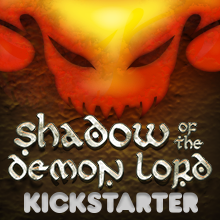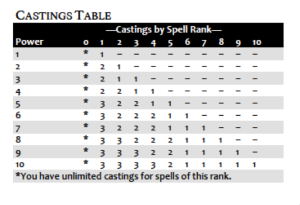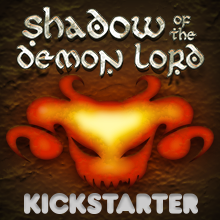 Shadow of the Demon Lord’s magic system has gone through some changes since design began, as it should. In a previous post, I discussed the direction I was taking and while much remains as it was then, I wanted to give you another look at the magic system.
Shadow of the Demon Lord’s magic system has gone through some changes since design began, as it should. In a previous post, I discussed the direction I was taking and while much remains as it was then, I wanted to give you another look at the magic system.
All Magic Is the Same
Spells, enchanted objects, artifacts, and magical abilities tap into the same source of power: magic. What mortals and immortals consider magic is the lingering potential left behind when the universe sprang into existence. So when a priest, magician, or rogue casts a spell, the power they draw to produce the magical effect comes from the same source. A psychic’s ability to read thoughts, a miracle performed by holy man and woman, flames loosed from a pyromancer’s fingertips, a vile curse loosed by a hag, or the dark power used to turn corpses into mindless zombies all use the same energy.
Power
The game uses the Power characteristic to describe a creature’s ability to call upon magical power and shape it into useful forms. All creatures have at least 0 Power. Player characters can grow their Power scores by choosing certain paths—magicians and priests increase Power and some rogues may increase their Power as well if they choose to dabble in magic. Expert paths and master paths can also increase Power.
Discovering Traditions
Traditions package spells that share a common theme or effect. Fire spells, for example, create or manipulate fire. Technomancy spells create mechanical devices like bolt throwers, grenades, and flamethrowers. Alchemy spells create magical substances.
To learn a spell, you must first discover the tradition to which the spell belongs. Your paths instruct you when you discover a tradition and usually give you a choice between discovering a new tradition or learning a new spell from a tradition you have discovered. When you discover the tradition, you also learn the tradition’s minor spell, a spell with a rank of 0.
Learning Spells
Your path tells you when you learn spells. When you learn a spell, you may choose any spell from any tradition you have discovered provided the spell’s rank is equal to or less than your Power score. So if you have 2 Power, you can learn spells of rank 2 or less from the traditions you have discovered.
Casting Spells
For each spell you learn, you have a number of castings for that spell. The number of castings depends on your Power and the rank of the spell.
Unless the spell description says otherwise, you use your action to cast the spell. When you cast the spell, you expend 1 casting from the number of castings you have. If you don’t have any castings left, the spell has no effect and the action is wasted. In other words, you need at least 1 casting to cast your spells.
Resolving the spell’s effect is easy. Each spell is a set of instructions. Follow them and voila, you cast the spell. Here are some of my favorite spells from the game. I hope we get to include them all in the book or the Demon Lord’s Companion pdf, but we’ll see!
Boon of the Demon Lord
Demonology Utility 1
Gain 1d6 insanity. If you do not go mad, increase your Health by 4d6 and you make action rolls, attack rolls, and resistance rolls with a boon. At the end of each round until the spell ends, roll a d6. On a 6, the spell ends.
Flamethrower
Technomancy Utility 2
Choose one pile of spare parts within your reach. If you concentrate on the spare parts for 1 minute, you construct a flamethrower from them. The flamethrower has 6 uses. When you expend the last use, the flamethrower crumbles into spare parts.
Any creature carrying the flamethrower may use its action to expend a use from it. Flames spread across a line-shaped area that is 1 yard wide and 10 yards long. Everything in the area takes 2d6 damage. A creature may make an Agility resistance roll. On a success, the creature takes no damage.
When a creature carrying the flamethrower takes damage from fire, it must roll a d6. On a 6, the device explodes, filling a sphere-shaped area with a 5-yard-radius with flames and then dissipates. Everything in the area takes 1d6 damage per unexpended use. A creature may make an Agility resistance roll. On a success, the creature takes half the damage.
Hole of Glory
Teleportation Utility 1
You may use your extra action on your turn to cast the spell. Choose two cubes of space, each 1-yard on a side. One of which must be within your reach and the other must be within medium range of you. A 1-foot-wide hole opens in the center each spot and can have any orientation you choose. The holes remain open for 1 minute and connect to each other such that you may reach into one hole and emerges from the other side. You can also attack creatures within 1 yard of the other side of the hole.
The hole severs whatever is in it when the spell ends with effects determined by the GM.
Mind Bondage
Enchantment Attack 2
Choose one creature that can see you, hear you, and is within medium range of you. Make an Intellect attack roll against the target’s Willpower score. You have a bane for your roll if the target has 20 Health or more. You make the roll with a bane if you or anyone with you attacked the target at any time within the last 24 hours. On a success, target becomes dazed for 1 minute. If you rolled a 20 on the die, the target is instead stunned for 1 minute. You have a boon for attack rolls made to socially interact with a target dazed or stunned by this spell. If the target takes damage, the affliction granted by this spell ends.
Minor Paradox
Time Attack 1
You may use your extra action on your turn to cast this spell. Choose one creature you can see within short range of you. Make an Intellect attack roll against the target’s Intellect score. On a success, the target no longer exists until the end of the next round. When the target reappears, it does so in the space it last occupied or in the nearest open space to it.
If you rolled a 20 on the die, you regain the casting of this spell.
Nightfall Blade
Shadow Utility 1
You may use your extra action on your turn to cast this spell. Wisps of darkness gather to form into a solid blade in the palm your hand. The blade remains for 1 minute or until the blade leaves your hand. When the effect ends, the blade evaporates into a cloud of smoke that disperses almost at once.
The blade functions as an off-hand weapon with the finesse property that deals 2d6 damage. The weapon deals 1d6 extra damage when you get a success on an attack roll against a target obscured by shadows or darkness.
Object Form
Transformation Utility 3
You assume the form of an object of your Size or smaller for as long as you concentrate, up to 8 hours. You make all decisions about what you look like while in this form. Until the effect ends, you cannot talk and you may only use your action to concentrate on this spell. You perceive using your normal senses however. You are physically indistinguishable from the object whose form you have assumed. The spell immediately ends if you take any damage.
Part Bone from Flesh
Forbidden Attack 3
Choose one living creature within medium range of you. If the target has a skeleton, make an Intellect attack roll against the target’s Strength score. On a success, the target takes 4d6 damage from the twisting and wrenching of its bones. If you rolled a 20 on the die, the target takes 2d6 extra damage.
If the damage incapacitates the target, it dies. The creature’s bones animate to become a skeleton that tears free from the flesh and attacks the nearest creature to it each round until it is destroyed.
Retribution
Arcana Attack 5
When a creature within short range of you gets a success on an attack roll using a weapon against you, you may use your extra action to cast this spell. The triggering creature’s success becomes a failure and its weapon is destroyed. In addition, the creature must make a Strength resistance roll. On a failure, it takes 10d6 damage, flies 2d6 yards in a straight line away from you, and falls prone.
Ubiquitous Assault
Battle Attack 3
Choose any number of creatures within a radius of up to one-half your Speed. Each target must make an Agility resistance roll with one bane. On a failure, the creature takes 4d6 + 3 damage.
After, you teleport to an open space any where within a number of yards of you equal to one-half your Speed.
Wicked Poltergeist
Spiritualism Attack 2
Choose one living creature within short range of you. Make a Willpower attack roll against the target’s Willpower score. On a success, a malevolent spirit appears in the air around the target and then plunges into it where it remains for 1 minute. Until the effect ends, the target’s Health is reduced by 2d6 and it becomes impaired and slowed. If you rolled a 20 on the die, the target reduces its Health by 3d6 instead.
Each creature within short range of the target, other than you, that sees the malevolent spirit appear must make a Willpower resistance roll. On a failure, the creature becomes frightened until the end of the next round.


